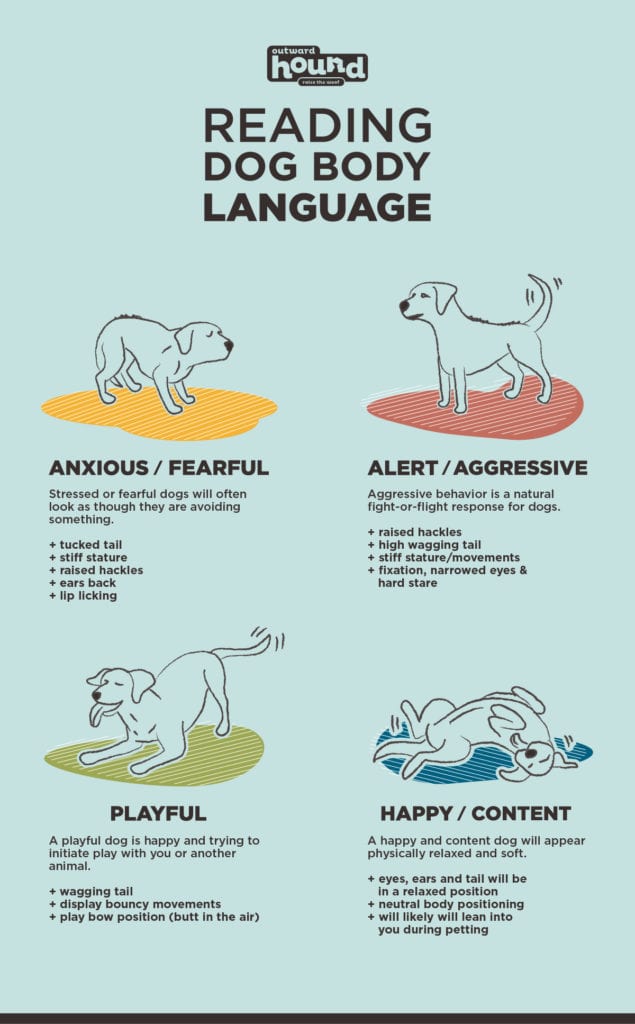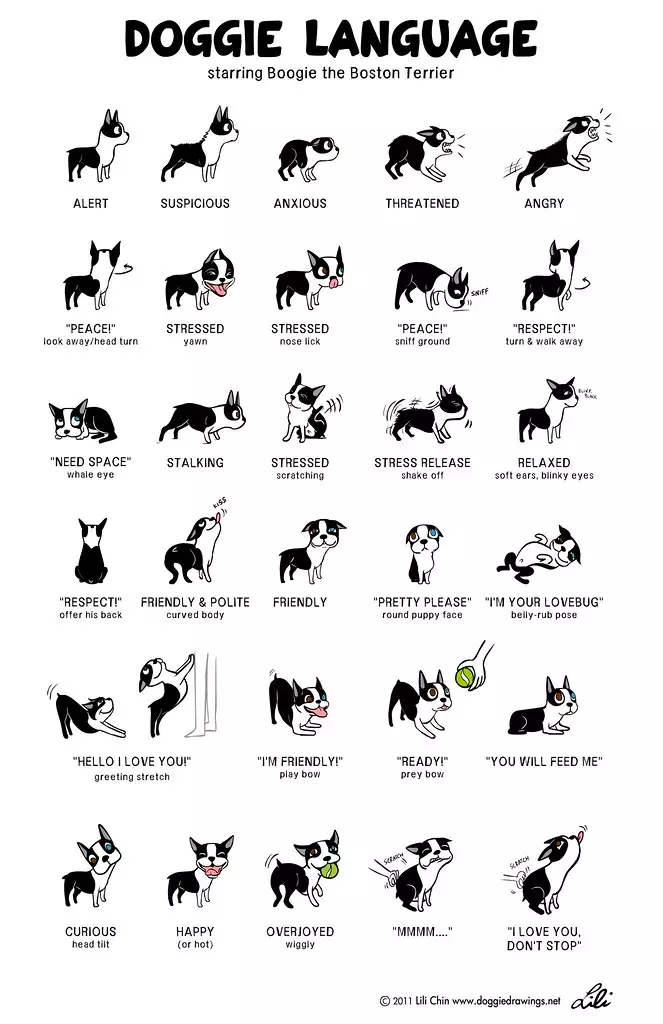Dogs communicate with us in many ways, and one of the most important is through their body language. Understanding your dog’s body language can help you build a stronger bond and ensure their well-being.
Have you ever wondered what your dog is trying to tell you? Dogs use their bodies to express their feelings and needs. From wagging tails to ear positions, each movement can reveal a lot. Knowing how to interpret these signals can help you respond better to your dog’s needs.
It can also prevent misunderstandings and potential problems. By learning to read your dog’s body language, you can create a happier, more harmonious relationship. Dive into the world of canine communication and discover what your furry friend is really saying.

Credit: outwardhound.com
Canine Communication Basics
Grasping your dog’s body language helps in building a strong bond. Notice tail wags, ear positions, and body posture. These signals reveal their feelings and needs.
Understanding your dog’s body language is essential for building a strong bond with your furry friend. Dogs communicate primarily through non-verbal cues, and grasping these signals can greatly enhance your interactions. By observing their facial expressions and postures, you can gain insights into their feelings and needs. This knowledge not only helps prevent misunderstandings but also allows you to respond to your dog’s emotions effectively.
Facial Expressions
A dog’s face can tell you a lot about their mood. Pay attention to their eyes. Are they wide and bright or narrowed and tense? Bright eyes often indicate happiness or curiosity, whereas tense eyes can suggest discomfort or anxiety.
Notice their ears too. If they’re perked up, your dog might be alert or excited. Ears that are pinned back can be a sign of fear or submission.
Even their mouth can communicate feelings. A relaxed, open mouth with a slightly hanging tongue usually means your dog is content. On the other hand, a closed mouth with tight lips could signal stress.
Postures
Your dog’s posture is another key component of their body language. When your dog stands tall with a wagging tail, they’re likely feeling confident and friendly. This is a great time for play and interaction.
However, if your dog is crouched low or has a tucked tail, they might be scared or uneasy. It’s crucial to approach them calmly and offer reassurance.
Watch for the playful bow, where your dog stretches their front legs and keeps their rear up. This posture invites playtime and signals that they are in a jovial mood.
Understanding these basic signals can transform your relationship with your dog. Have you ever noticed how your dog reacts to your mood? Observing these cues can deepen your connection and ensure both of you enjoy happy, harmonious moments together.

Credit: www.petco.com
Tail Movements And Meanings
Dogs use their tails to communicate emotions. A wagging tail often signals happiness, while a tucked tail can indicate fear. Understanding these signals helps in responding to your dog’s needs.
Understanding your dog’s body language can be fascinating and incredibly useful. One of the key aspects is their tail movements. Knowing what different tail movements mean can help you better understand your dog’s emotions and needs. Let’s dive into the specifics of tail movements and meanings.
Wagging Styles
Dogs wag their tails in different ways, and each style can signify something unique. A broad, sweeping wag often means your dog is happy and friendly. If your dog’s tail wag is faster and more vigorous, they might be super excited or anxious.
Imagine your dog sees you after a long day. If their tail is wagging in big, enthusiastic sweeps, they’re thrilled to see you. On the other hand, a slow, tentative wag can signal that your dog is unsure or feeling cautious.
Tail Position
The position of your dog’s tail also conveys important information. A tail held high usually indicates alertness and confidence. When your dog’s tail is low or tucked between their legs, it often means they’re scared or submissive.
Think about the last time your dog met a new person or pet. If their tail was high and wagging, they were likely feeling confident and friendly. However, if their tail was down, they might have felt threatened or uncomfortable.
Understanding these nuances can help you respond appropriately to your dog’s needs.
What does your dog’s tail say about their current mood? Pay close attention and you might be surprised by the insights you gain.
Vocalizations And Their Context
Understanding your dog’s vocalizations is key to deciphering their mood. Dogs use sounds to express feelings and needs. Each type of sound has its own context. Recognizing these sounds helps you respond appropriately.
Different sounds convey different messages. Knowing the context can prevent misunderstandings. Let’s explore common vocalizations and their meanings.
Barking Types
Barking is the most common vocalization. Dogs bark for various reasons. High-pitched barks often signal excitement. They might bark when they see a friend. Rapid barking can indicate alertness. Your dog may sense danger or a stranger.
Low, slow barks often mean your dog feels threatened. These barks are deeper and more serious. Understanding the pitch and frequency helps you understand your dog’s emotions.
Whining And Growling
Whining often means your dog wants attention. It can signal discomfort or anxiety. Puppies whine more than adult dogs. They use whining to communicate needs.
Growling is another important vocalization. It usually means your dog feels threatened. Growling can be a warning. It tells others to back off. Pay attention to the context and body language. Your dog may be protecting their territory.
Recognizing these sounds helps you respond correctly. It can improve your relationship with your dog.
Understanding Eye Contact
Understanding your dog’s eye contact can help strengthen your bond. Dogs use their eyes to communicate their feelings and intentions. By observing their eye contact, you can better understand their needs and emotions. In this section, we will explore two key aspects of eye contact in dogs: direct stares and avoiding eye contact.
Direct Stares
Direct stares from your dog can mean different things. If your dog gazes at you softly, it often shows love and trust. This type of eye contact is calm and relaxed. It indicates that your dog feels safe and secure.
On the other hand, a hard stare can signal aggression or dominance. If your dog’s eyes are wide, and they maintain intense eye contact, they might be feeling threatened. In such cases, it’s best to avoid direct confrontation.
Avoiding Eye Contact
When a dog avoids eye contact, it usually shows submission or fear. Lowering their gaze or turning their head away can indicate they are not a threat. This behavior is common in dogs trying to avoid conflict.
Sometimes, avoiding eye contact can also mean your dog is anxious or uncomfortable. If you notice this, try to identify the source of their discomfort. Providing comfort and reassurance can help ease their anxiety.

Credit: bowwowinsurance.com.au
Frequently Asked Questions
How Do I Read My Dog’s Body Language?
Observe your dog’s posture, tail, ears, and eyes. A wagging tail often means happiness, while a tucked tail signifies fear. Erect ears show alertness, while flattened ears indicate submission. Relaxed eyes suggest calmness; wide eyes can mean anxiety.
What Are 5 Common Body Language Signals That Tell You That A Dog Is Stressed?
Dogs show stress through panting, excessive drooling, yawning, tucked tails, and avoiding eye contact.
How Do I Tell My Dog I Love Him?
Show your dog love by petting them gently, speaking softly, playing together, giving treats, and spending quality time.
How Do You Tell If Your Dog Is Bonded To You?
A bonded dog shows affection, follows you, seeks your attention, and enjoys spending time together. They are loyal and trusting.
How Can I Tell If My Dog Is Happy?
A wagging tail, relaxed body, and bright eyes usually mean your dog is happy.
Conclusion
Understanding your dog’s body language is essential for a stronger bond. Observe their signals daily. Notice the wagging tail, relaxed ears, or playful bark. These cues reveal their emotions. Always pay close attention to changes. This helps in identifying stress or discomfort early.
Building this awareness fosters a happier, healthier relationship. Practice patience and consistency. Communicate with your dog effectively. This mutual understanding brings joy and trust. Embrace this learning journey with your furry friend. It enhances your connection and their well-being. Enjoy your time together, and cherish every moment.
Last Updated on June 27, 2025 by Pauline G. Carter

